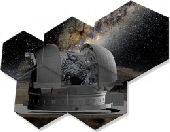Italian language:
Dopo 16 mesi di inattività per i più svariati motivi, torno con le primissime immagini (come si dice la “prima luce”) eseguite col nuovo telescopio da 20″ in configurazione Dall-Kirkahm sistemato dentro la cupola del mio osservatorio.
Questa composizione di 5 riprese, eseguite la notte tra il 17 ed il 18 ottobre scorso in condizioni di seeing sufficienti ma non eccelse (stimato 6,5 della scala Pickering nel canale IR a 685nm) è centrata sul Polo Sud lunare, una delle mie zone preferite.
Il nuovo telescopio (che potete vedere proprio durante questa sessione di riprese al link – http://www.carmelozannelli.com/site/wp-content/uploads/2011/07/IMG_20191018_001650_.jpg – è ormai nella fase finale della messa a punto, poichè si tratta di un prototipo che necessitava di diverse ottimizzazioni e settaggi per funzionare al top delle sue possibilità.
Ormai posso dire che l’unico limite alla risoluzione di questo 51 cm sarà solo il seeing.
Passando alla disamina dei maggiori crateri visibili, dal bordo sinistro in ombra ed in ordine orario, iniziamo col cratere “Mutus” il cui fondo è totalmente in ombra, per andare verso “Manzinus” che risulta anch’esso per circa tre quarti col fondo in ombra, “Schomberger” di cui è visibile solo una sottilissima parte del lembo sud/est (in foto a in alto del cratere poichè la visione è rovesciata), sotto di esso la coppia di crateri “Simpelius” e Simpelius A, i crateri “Pentland”, “Kinau”, “Jacobi”, “Zach”, il bel cratere “Curtius” esattamente al centro dell’immagine e, alla cui destra, si trova lo splendido cratere “Moretus” di circa 115 Km. di diametro, caratterizzato da un bordo interno terrazzato e un complesso bastione esterno. Il fondo del cratere è stato parzialmente ricoperto dalla lava ed è relativamente piatto, al cui centro si trova la bellissima formazione montuosa a picco centrale che si erge per circa 2,1 chilometri sopra il fondo circostante. Accanto a Moretus vi sono anche i crateri “Cysatus”, “Gruemberger”, “Newton” (quasi pienamente illuminato ma in posizione molto obliqua) per terminare al bordo destro con la coppia di crateri “Casatus” e Klaproth” ed infine “Blancanus” in bella evidenza vicino il bordo basso a dx della foto.
Infine voglio ringraziare l’amico Massimiliano Veschini per i suoi pareri in fase di pre-elaborazione: come si dice sempre (ed è vero) quattro occhi son meglio di due!
Grazie, come sempre, per la Vs. cortese attenzione e alla prossima!
Dettagli tecnici:
Telescopio AstrofaKtoria DK-20 @ ~ F/19 – Baader FFC Multiplier – Baader IR 685nm filter – GS3-U323S6M-C camera – Seeing 6,5/10 max in IR band – sito: Palermo @ my personal Observatory.
English:
After 16 months of inactivity for the most varied reasons, I come back with the very first images (as they say the “first light” of my scope) performed with the new 20″ telescope in Dall-Kirkahm configuration, placed inside the dome of my observatory.
This composition of 5 shots, taken in the night between last 17 and 18 October in fair but not excellent seeing conditions (estimated 6,5 on the Pickering scale in the 685nm IR channel) is centered on the lunar South Pole, one of my favorite zones. The new telescope (which you can see right during this capturing session at the link – http://www.carmelozannelli.com/site/wp-content/uploads/2011/07/IMG_20191018_001650_.jpg – is now in the final phase of the development, as it is a prototype that needed different optimizations and settings to work at the top of its possibilities.
By now I can say that the only limit to the resolution of this 51 cm telescope will be only the seeing.
Talking about the examination of the major visible craters, from the left edge in shadow and in hourly order, we start with the crater “Mutus” whose bottom is totally in shadow, to go towards “Manzinus” which is also about three quarters with the floor in shadow, “Schomberger” of which only a very thin part of the south-east edge is visible (in the photo at the top of the crater as the vision is inverted) below it the pair of craters “Simpelius” and Simpelius A, the craters “Pentland”,”Kinau”,”Jacobi”,”Zach”, the beautiful “Curtius” crater exactly in the center of the image and, next to the right of it, is the splendid “Moretus” crater of about 115 Km in diameter, characterized by a terraced interior edge and a complex external bastion. The floor of the crater has been partially covered by lava and is relatively flat, at the center of which is the beautiful mountain peak formation that rises about 2.1 kilometers above the surrounding floor. Next to Moretus there are also the craters “Cysatus”, “Gruemberger”, “Newton” (almost fully illuminated but in a very oblique position) to end at the right edge with the pair of craters “Casatus” and “Klaproth” and finally “Blancanus” prominently near the lower edge on the right of the photo.
Thank you very much for your kind attention and see you soon with other lunar shots!
Technical details:
Astrofaktoria Dall-Kirkahm 20″ Telescope @ ~ F/18 – Baader FFC Multiplier – Baader IR 685nm filter – GS3-U323S6M-C camera – Seeing 6.5/10 max in IR band – site: Palermo @ my personal Observatory.
Ad maiora semper!
Carmelo “Mel” Zannelli


One Comment
This site really has all the info I needed concerning this subject and didn at know who to ask. Bettine Osbourn Avilla